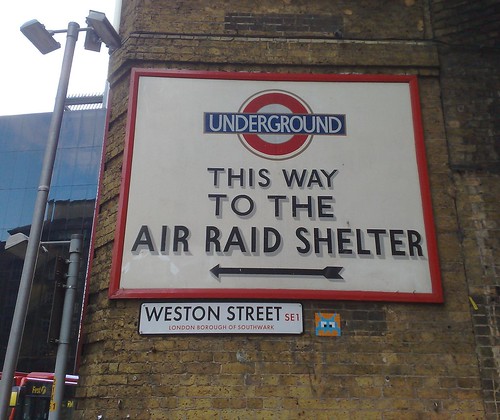
I've been reading this biography of Ove Arup (who was the hot-shit engineer, for what that's worth), and while it contains all of what irritates me about the biography genre -- who really cares about the minute relationship details of an angsty 20-something, even if they go on to Do Great Things? -- it also has a fascinating history of the architecture and politics of WWII-era British bomb shelters which are an example of the ways in which design matters.
During WWI, there were no private shelters and the London tube stations were used extensively, with some success ('only' 670 deaths to aerial bombing in the city). For the second act, uninterupted tube service was desired, so they were ruled out. Dedicated underground shelters were judges too costly to universally provide, so they were ruled out. Trenches in public parks were found to save burial costs, but few lives. Instead, Sir John Anderson, the Home Secretary, promoted the shelters you see below.

They were cheaply made corrugated iron and steel structures, typically placed in domestic gardens, and capable of holding half a dozen adults: conscientious families half buried them in the earth and covered them with vegetation.
-Peter Jones in Ove Arup
Yes, the pictured shelter features a gasmask-clad stuffed animal hood ornament -- who says building your own bomb shelter can't be a hilarious? Anderson's government distributed several million of these structures during the early war years, all the while fought by Arup (among others), who argued for deep concrete shelters at the neighborhood-level. "Engineer advocates massive infrastructure project" is not exactly a shocking headline, but this time there was justification.
The Anderson shelters chief virtue was cheapness, but they were not particularly effective at life safety (relative to the tubes) or comfortable to use. As a partially buried structure with no waterproofing or even finish floor, a few inches of water would collect at the floor, making any extended stay in the shelter cold and wet. This may seem beside the point given the circumstances - surely, the end user's sole concern here is avoiding death!
However, bombings are not constant. Given a lapse, there is an understandable tendency to flee miserable dwelling and return to the exhorbitant luxury of floors and dryness. What protection Anderson shelter's did offer was proportionally reduced whenever tenants opted out, placing themselves at risk of a surprise assault. By the late 40s Sir John was promoted out of his post and the shelters that bore his name abandoned in favor of other options.
The important conclusion here, other than concrete >> corrugated metal, is that design is important! Even during air raids - especially during, when violence compresses decision-making -- design affects behavior, so it should be consciously considered. In the extreme case, it can save lives. Or at least keep your socks dry, which is almost as important.
(Photos from Flickr user Richard Parmiter and Ove Arup: Masterbuilder of the Twentieth Century. The original full-sized versions can be viewed by clicking the photo.)

No comments:
Post a Comment